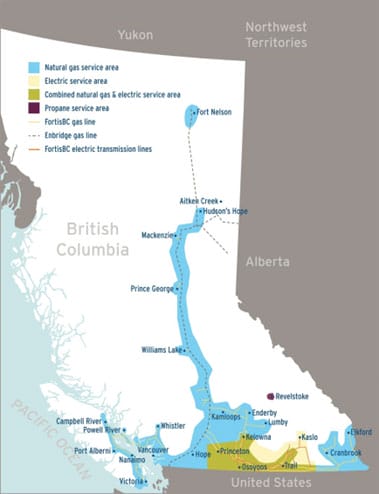Different Types of Extension Cords
Contrary to popular belief, there are many different types of extension cords.
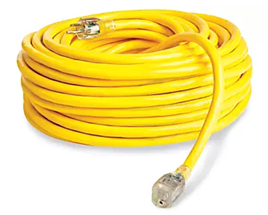 Different applications may require different amperages so it’s good to have a basic understanding of how electrical cords differ and how they should be used.
Different applications may require different amperages so it’s good to have a basic understanding of how electrical cords differ and how they should be used.
In this post, our Premium Electric electricians will cover many of the basics including:
- Types of extension cords
- Indoor vs outdoor cords
- 3 prong vs 2 prong cords
- Extension cord amp ratings
- Wire gauges
- GFCI cords
- Electrical cord safety tips
Not Any Old Extension Cord Will Do
Yes, it does matter which power extension cord you use as well as when to use it and for what. It’s not just us electricians being pedantic.
Picture this. You’re hanging up your outdoor Christmas lights. As you go to plug them in, of course, the cord doesn’t quite reach that outdoor outlet (yes, that one presumably installed for this precise purpose). You know you have an unused electrical cord just lying around in your shed. Bingo! Problem solved. Well, not so fast…
According to Electrical Safety Foundation International (ESFi), improperly used extension cords account for “Roughly 3,300 home fires … each year, killing 50 people and injuring 270 more.”
In other words, just because you have an extra electrical cord lying around, it doesn’t mean you can, or should, use it for just any old purpose.
While some types of extension cords are good for indoor use only, others are only meant for outdoor use. Some may be good for 3-prong plugs only while others may be 2-prong only or good for both. Some electrical cords are waterproof, and some are not.
Do you get the picture?
You need to know the type of extension cord you need and how to use them properly to prevent electrical shocks or electrical fires and to ensure the electrical safety of home and family.
 Extension Cord Types
Extension Cord Types
Here are some basic tips on the different types of extension cords plus general knowledge information for safe electrical cord usage.
Outdoors vs. Indoors Electrical Cords
Not all extension cord types are appropriate for outdoor use.
Think about it: rain jackets were made for a reason – because they are waterproof. Why then would you use the type of extension cord that doesn’t offer the same sort of protection against the outdoor elements?
So, how do you tell if an electrical cord is good for outdoor use?
As a rule of thumb, outdoor heavy-duty extension cords are covered in a protective, weather-durable layer of insulation and tend to be thicker than indoor cords. In general, outdoor electrical cords are also longer and able to carry more electrical current.
Since different types of extension cords have different uses, you can check for the following signs that the cord is rated for outdoor use:
- Extra-long extension cords tend to be meant for outdoor use.
- Waterproof electrical cords also tend to be for outdoor use.
- Look for the letter “W” on the packaging or on the electrical cord itself – the “W” designates the cord in question as being for outdoor use.
- Look for power extension cords that are bright orange in colour – this insulated orange covering (plastic, rubber, or vinyl) is a sign that the electrical cord is for outdoor use and will protect against the elements (water, temperature, sunlight, etc.).
- Look for a cord with 3-prong plugs only. That third prong is your protective ground. Outdoor extension cords have 3-prongs rather than 2-prong plugs.
- Look for cords with higher amperage ratings – outdoor extension cords are more powerful and able to carry more current and will thus have a higher amperage rating.
 3-Prong vs. 2-Prong Plug Type
3-Prong vs. 2-Prong Plug Type
As mentioned above, outdoor electrical outlets all have 3-prong plugs, while some indoor outlets may still have only 2-prong plugs.
What’s the difference between 3-prong vs 2-prong types of extension cords?
Three prong plugs are grounded. On an outlet, that third hole, the round one you see below and between the two vertical slits in a 3-prong outlet – serves to ground the plug. See our post on Types of Electrical Outlets.
This helps to eliminate electrical shocks and prevent fires in the event of a malfunction at any point in the electrical circuit.
Extension Cord Amperage Ratings
We’ve already talked about how outdoor cords tend to have a higher amperage rating than indoor cords. This is because outdoor extension cords tend to be used for tools requiring more electrical current. These may include power tools like saws, mowers, sanders, etc.
But what exactly is amperage?
At its simplest, amperage refers to the amount of electrical current flowing through a conductor (an electrical cord being the conductor in this case).
Different types of extension cords are rated according to how much amperage – or electrical current – they can handle. Some can carry more, some less.
Cord amp ratings are based on the wire gauge and the cord’s amperage (how much electricity they can carry). Higher wire gauge numbers like 16 or 18 take less amperage and lower wire gauge numbers like 14 or 12 can handle more amperage.
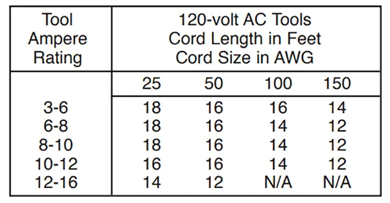
This information should be listed on the device itself or in its user manual.
When choosing the right type of extension cord for the job, you must ensure that the amperage rating for the cord and the electrical device that will plug into it are equivalent.
The electrical cord must be able to handle the equivalent or more electrical current. The wire gauge will also play a part in this.
Wire Gauge
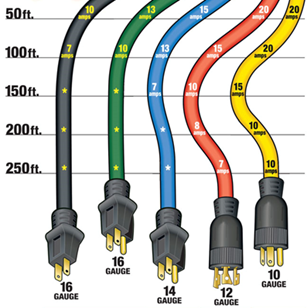
Wire gauge may also be referred to as AWG or American Wire Gauge – which is also used in Canada. And by size in relation to gauge, we are referring to the thickness or diameter of the wire.
Why is this important? Because the thickness of the wire affects:
- How much electrical current or power the wire can safely carry.
- And how much the wire heats up during the process of carrying said current (with hotter obviously being more dangerous).
When it comes to wire gauges, it’s important to remember the following:
- The smaller the number, the thicker the wire, and the greater its capacity to deliver current or power: low number = thicker wire = more current
- The bigger the number, the thinner the wire, and the smaller the wire’s capacity to deliver current: high number = thinner wire = less current
Wire Gauge Sizes – Let’s look at 16-gauge vs. 10-gauge electrical cords (being that 16-, 14-, 12- and 10-gauge are the most common sizes when it comes to power extension cord wiring).
16-Gauge Wire – Using the above equation, the 16-gauge cord would be a thinner wire than the 10-gauge. This makes it less able to deliver large amounts of current, which renders it useful only for light-duty types of extension cords. A 16-gauge wire is mostly used for things like powering your bedside lamp, a small portable fan, or some other common, light-on-power household items.
10-Gauge Wire – The 10-gauge cord, on the other hand, with its smaller number, indicates that it is a thicker wire with a greater capacity to carry larger power loads. This extra heavy-duty extension cord wiring is useful for big-ticket (and power-hungry) items like chainsaws, table saws, circular saws… all the saws, really, as well as other burly power tools.
Ground Fault Circuit Interrupter (GFCI)
Finally, there are types of extension cords that come with their very own built-in safety plan.
This GFCI electrical cord includes a ground fault circuit interrupter (GFCI). It is designed to automatically cut the flow of electricity should any sort of malfunction or fault occur. This type of extension cord, with a built-in GFCI, is always going to be your best, safest, bet. Plus, it comes in both indoor and outdoor versions.
You can learn more about this topic on our GFCI site page.
Tips for Safe Extension Cord Usage
Even if you’ve chosen the correct type of extension cord, for the correct appliance, in the correct locale, there are a few more safety tips to keep in mind including:
- Never, ever use a damaged cord – no matter how minor the damage may look to you. Cracked casing, loose wires, loose connections, fraying sockets. These are not a good look for your extension cord – or your personal safety.
- Never staple an electrical cord into your walls or baseboards.
- Never plug multiple cords into one another – use one power extension cord for one purpose.
- Never use an indoor-rated cord for outdoor use.
- Never use an electrical cord with an amperage rating less than the device it’s being used for. The extension cord amperage rating must meet or exceed the amperage rating of the electrical device it’s powering.
- Even though it’s rated for outdoor use, don’t leave your outdoor electrical cord lying around in the snow or standing water. It’s still an electrical conductor, not an alligator.
- If your home is littered with electrical cords, it means you have too few direct-wall outlets. Call an electrician to assess your outlet situation. You may need a wiring upgrade to install more outlets. Too many cords are never a good thing.
See our blog post for additional Extension Cord Safety Tips.
When it comes to all things electrical, even the ostensibly simple things like types of extension cords and how they are used:
- There are no stupid questions.
- DIY is never a good idea if you think plugging multiple electrical cords into one another is fine!
About Premium Electric

We offer expert electrical services to clients throughout the Fraser Valley and Vancouver Lower Mainland from Chilliwack and Abbotsford to Surrey and Burnaby.
No job is too big or too small so call us if you need:
We are here to help.
Do you still have a question about the different types of extension cords?
We are available 24/7 at 604-308-6195
You can also contact us online or reach us by email.

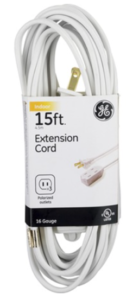 Extension Cord Types
Extension Cord Types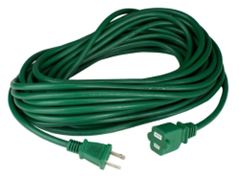 3-Prong vs. 2-Prong Plug Type
3-Prong vs. 2-Prong Plug Type